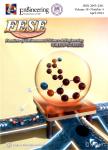Selective recovery of Cu2+ and Ni2+ from wastewater using bioelectrochemical system
从用 bioelectrochemical 系统的废水的 Cu2+ 和 Ni2+ 的选择恢复作者机构:School of Environmental Science and Engineering Guangdong Provincial Key Laboratory of Environmental Pollution Control and Remediation Technology Sun Yat-sen University
出 版 物:《Frontiers of Environmental Science & Engineering》 (环境科学与工程前沿(英文))
年 卷 期:2015年第9卷第3期
页 面:522-527页
核心收录:
学科分类:083002[工学-环境工程] 0830[工学-环境科学与工程(可授工学、理学、农学学位)] 08[工学]
基 金:supported by the National Natural Science Foundation of China(Grant Nos.51039007,51179212,and51278500) the program of Guangzhou Science&Technology Department(No.2012J4300115) the research fund program of Guangdong provincial key laboratory of environmental pollution control and remediation technology(No.2013K0002) the research fund program of key laboratory of water and air pollution control of Guangdong Province(No.GD2012A01)
主 题:bioelectrochemical system Cu2+ Ni2+ selective recovery
摘 要:As the bioelectrochemical system, the microbial fuel cell(MFC) and the microbial electrolysis cell(MEC) were developed to selectively recover Cu2+and Ni2+ions from wastewater. The wastewater was treated in the cathode chambers of the system, in which Cu2+and Ni2+ions were removed by using the MFC and the MEC,respectively. At an initial Cu2+concentration of 500 mg$L–1, removal efficiencies of Cu2+increased from 97.0% 1.8% to 99.0% 0.3% with the initial Ni2+concentrations from 250 to 1000 mg$L–1, and maximum power densities increased from 3.1 0.5 to 5.4 0.6 W$m–3. The Ni2+removal mass in the MEC increased from 6.8 0.2 to20.5 1.5 mg with the increase of Ni2+concentrations. At an initial Ni2+concentration of 500 mg$L–1, Cu2+removal efficiencies decreased from 99.1% 0.3% to 74.2% 3.8%with the initial Cu2+concentrations from 250 to 1000 mg$L–1, and maximum power densities increased from3.0 0.1 to 6.3 1.2 W$m–3. Subsequently, the Ni2+removal efficiencies decreased from 96.9% 3.1% to73.3% 5.4%. The results clearly demonstrated the feasibility of selective recovery of Cu2+and Ni2+from the wastewater using the bioelectrochemical system.



